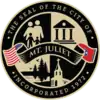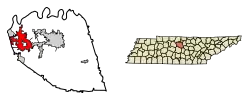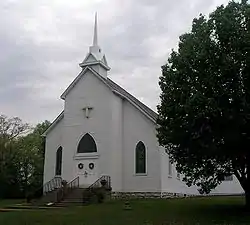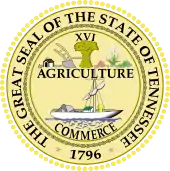Mount Juliet, Tennessee
Mt. Juliet[6] (also known as Mount Juliet) is a city located in western Wilson County, Tennessee. A suburb of Nashville, it is approximately 17 miles (27 km) east of downtown Nashville. Mt. Juliet is located mostly between two major national east-west routes, Interstate 40 and U.S. Route 70. As of 2010, Mount Juliet has a population of approximately 23,671 people. Mt. Juliet is the largest city in Wilson County. The official city charter has the name listed as Mt. Juliet;[7] however, the United States Postal Service lists the name as Mount Juliet.[8]
Mt. Juliet, Tennessee
Mount Juliet | |
|---|---|
City | |
| City of Mt. Juliet | |
 Seal | |
| Motto(s): City Between The Lakes | |
 Location of Mount Juliet in Wilson County, Tennessee. | |
| Coordinates: 36°12′10″N 86°30′49″W | |
| Country | United States |
| State | Tennessee |
| County | Wilson |
| Incorporated | 1972[1][2] |
| Named for | Mount Juliet Estate (County Kilkenny, Ireland)[3] |
| Government | |
| • Type | Council-Manager |
| • Mayor | Ed Hagerty |
| • City Manager | Kenny Martin |
| • Vice Mayor | James Maness |
| • City Commissioners | Ray Justice, Art Giles, Jennifer Miele |
| Area | |
| • Total | 25.38 sq mi (65.74 km2) |
| • Land | 25.06 sq mi (64.91 km2) |
| • Water | 0.32 sq mi (0.83 km2) |
| Elevation | 683 ft (208 m) |
| Population (2010) | |
| • Total | 23,671 |
| • Estimate (2019)[5] | 37,029 |
| • Density | 1,477.50/sq mi (570.46/km2) |
| Time zone | UTC-6 (CST) |
| • Summer (DST) | UTC-5 (CDT) |
| ZIP code | 37121 (P.O. boxes) 37122 (gen. delivery) 37138 (northwestern gen. delivery) |
| Area code(s) | 615, 629 |
| FIPS code | 47-50780 |
| Website | www.mtjuliet-tn.gov |
History

Mt. Juliet was formed in 1835 and incorporated as a city in 1972.[1][2] The most widely accepted theory regarding the naming of the town is that it is named for the Mount Juliet Estate, a manor house in County Kilkenny, Ireland. It is the only U.S. city with this name.[9]
In the early morning hours of March 3, 2020, Mt. Juliet was struck by an EF 3 tornado that destroyed an entire neighborhood and 2 public schools and killed 3 people.[10]
Geography
_welcoming_commuters_to_Mt._Juliet..jpg.webp)
Mt. Juliet is located at 36°12'10" North, 86°30'49" West (36.202654, −86.513583).[11]
According to the United States Census Bureau, the city has a total area of 16.6 square miles (43 km2), of which 16.2 square miles (42 km2) is land and 0.3 square miles (0.78 km2) is water. The total area is 1.99% water. Recent annexations along the east side of South Rutland Road as well as a land swap with the City of Lebanon for the Bel Air at Beckwith project (southeast quadrant of I-40/Beckwith Road interchange) have increased the city's geographical area to approximately 21.78 square miles (56.4 km2).
Mt. Juliet is located between Old Hickory Lake to its north and Percy Priest Lake to its south, both of which are man-made reservoirs.
Demographics
| Historical population | |||
|---|---|---|---|
| Census | Pop. | %± | |
| 1980 | 2,879 | — | |
| 1990 | 5,389 | 87.2% | |
| 2000 | 12,366 | 129.5% | |
| 2010 | 23,671 | 91.4% | |
| 2019 (est.) | 37,029 | [5] | 56.4% |
| Sources:[12][13] | |||
Mt. Juliet has claimed to be the "fastest-growing city in Tennessee," and it does qualify for this distinction if one considers growth from 2000 to 2015 for Tennessee cities with a population over 10,000. In recent years, Thompsons Station in Williamson County and Spring Hill in Williamson County have grown by a larger percentage basis. Mt. Juliet remains one of the fastest growing places in Tennessee.
2010 census
As of the census of 2010,[14] there were 23,671 people, 8,562 households, and 6,674 families residing in the city. The population density was 958.34 persons per square mile, and the housing unit density was 346.64 units per square mile. The racial makeup of the city was 86.92% White, 6.70% Black or African American, 2.47% Asian, 0.44% Native American, 0.05% Pacific Islander, 1.42% from other races, and 2.00% from two or more races. Those of Hispanic or Latino origins were 3.32% of the population.
Of the 8,562 households, 41.35% had children under the age of 18 living in them, 62.14% were married couples living together, 4.04% had a male householder with no wife present, 11.77% had a female householder with no husband present, and 22.05% were non-families. 17.96% of all households were made up of individuals, and 5.49% had someone living alone who was 65 years of age or older. The average household size was 2.75 and the average family size was 3.13.
In the city, the population was spread out, with 28.68% under the age of 18, 62.57% ages 18 to 64, and 8.75% ages 65 and over. The median age was 35.7 years. 52.00% of the population was female and 48.00% was male.
The median household income was $70,102, and the median family income was $76,585. Males had a median income of $52,841, versus $41,179 for females. The per capita income was $28,699. About 4.6% of families and 5.4% of the population were below the poverty line, including 6.6% of those under the age of 18 and 3.8% of those age 65 and over.
2000 census
As of the census[15] of 2000, there were 12,366 people, 4,341 households, and 3,576 families residing in the city. The population density was 761.2 people per square mile (293.8/km2). There were 4,673 housing units at an average density of 287.6 per square mile (111.0/km2). The racial makeup of the city was 93.86% Caucasian, 3.93% African American, 0.39% Native American, 0.52% Asian, 0.01% Pacific Islander, 0.29% from other races, and 1.00% from two or more races. 1.17% of the population were Hispanic or Latino of any race.
There were 4,341 households, out of which 46.0% had children under the age of 18 living with them, 67.3% were married couples living together, 11.2% had a female householder with no husband present, and 17.6% were non-families. 13.8 percent of all households were made up of individuals, and 3.3% had someone living alone who was 65 years of age or older. The average household size was 2.82 and the average family size was 3.12.
In the city, the population was spread out, with 30.5% under the age of 18, 6.5% from 18 to 24, 35.3% from 25 to 44, 21.4% from 45 to 64, and 6.3% who were 65 years of age or older. The median age was 34 years. For every 100 females, there were 95.4 males. For every 100 females age 18 and over, there were 93.4 males.
In 2017, the median income household income was $80,130. The medium value of owner-occupied housing units is $238,700 and 7% of the population and 1.7% of families were below the poverty line. 3.2% of those under the age of 18 and 4.0% of those 65 and older were living below the poverty line. Wilson County is the 2nd wealthiest county in Tennessee.

Government and politics
Mt. Juliet operates on a "city manager-commission" system.[2] It has five elected leaders: four commissioners elected by district and a mayor elected at-large. The mayor serves as chairperson of the city commission. All five officials serve four-year terms, and are officially part-time employees. The commission selects and appoints a city manager, who is employed full-time and runs the city's business on a day-to-day basis.
Mt. Juliet currently serves as the anchor city for Tennessee House of Representatives District 57 and Tennessee Senate District 17. As of 2019, Mt. Juliet is in Tennessee's 6th congressional district.
Education
Mt. Juliet's public schools are operated by the Wilson County School District. Schools that serve Mt. Juliet include Mt. Juliet High School and Green Hill High School.[16]
Transportation
Interstate 40 and U.S. Route 70 (Lebanon Road) run east/west through Mt. Juliet, and State Route 171 (Mt Juliet Road) runs north-to-south connecting US-70 to I-40, before continuing toward Interstate 24 in the Antioch area. Interstate 40 has two exits in the city.[17]
Mt. Juliet serves as a stop on the Music City Star commuter rail service from Nashville to Lebanon, operating over freight carrier Nashville and Eastern Railroad. The Music City star has stations in downtown Nashville, Donelson, Hermitage, Mt. Juliet, Martha (State Route 109), and Lebanon. The Music City Star also runs trains for Tennessee Titans games, New Year's Eve, Wilson County Fair, other events downtown Nashville. Additionally, a Friday night train has been added to give Mt. Juliet residents the option of taking the train for Friday night excursions.
For commercial air traffic, Mt. Juliet is served by Nashville International Airport, located 9 miles (14 km) west of the city via Interstate 40.
City services
The City of Mt. Juliet operates a police department. Ambulance service are provided by WEMA (the Wilson Emergency Management Agency). The city has a combination career and volunteer Fire Department (MJFD) with one station on Belinda Parkway and another station located on Hill Street.[18] MJFD is currently in discussions to open a third fire station on the north side of Mt. Juliet. There is one WEMA fire station also within the city limits. Mt. Juliet has a new police station near Charlie Daniels Park on the city's northwest side. In December 2008, the Mt. Juliet Police Department Animal Control Division opened a shelter on Industrial Drive.
Notable people
- Muriel Bevis, athlete
- Mae Beavers, Member of the Tennessee Senate[19]
- Bjorn Bjorholm, bonsai artist
- Levi Brown, professional football player
- Amanda Butler, basketball coach
- Alysha Clark, professional basketball player
- Bobby Hamilton, NASCAR driver
- Michael Jasper, professional football player
- Chase Montgomery, NASCAR driver
- Don Ray, professional basketball player
- Dale Wainwright, Texas Supreme Court
- Barry Wilmore, astronaut
- Ross Winn, politician
References
- "CITY MANAGER-COMMISSION CHARTER" (PDF). Mount Juliet, Tennessee. p. C-1. Archived from the original (PDF) on November 29, 2014. Retrieved November 16, 2014.
- Larry Miller, Tennessee Place Names (Indiana University Press, 2001), p. 144.
- "2019 U.S. Gazetteer Files". United States Census Bureau. Retrieved July 30, 2020.
- "Population and Housing Unit Estimates". United States Census Bureau. May 24, 2020. Retrieved May 27, 2020.
- "Municode Library". library.municode.com. Retrieved May 26, 2017.
- "Municode Library". www.municode.com. Retrieved May 26, 2017.
- "USPS.com® - ZIP Code™ Lookup". tools.usps.com. Retrieved May 26, 2017.
- "Mt. Juliet West Wilson Chamber of Commerce – Community Information". Archived from the original on April 3, 2007.
- "NWS: Tornado that hit Nashville and Mt. Juliet was on the ground for 50 miles". WMC-TV. Nashville, Tennessee. March 4, 2020. Retrieved September 9, 2020.
- "US Gazetteer files: 2010, 2000, and 1990". United States Census Bureau. February 12, 2011. Retrieved April 23, 2011.
- "Census of Population and Housing: Decennial Censuses". United States Census Bureau. Retrieved March 4, 2012.
- "Incorporated Places and Minor Civil Divisions Datasets: Subcounty Resident Population Estimates: April 1, 2010 to July 1, 2012". Population Estimates. U.S. Census Bureau. Archived from the original on June 11, 2013. Retrieved December 11, 2013.
- "Mount Juliet city, Tennessee". United States Census Bureau. 2010. Retrieved December 16, 2019.
- "U.S. Census website". United States Census Bureau. Retrieved January 31, 2008.
- "Wilson County School District / Homepage" Check
|url=value (help). http. - Tennessee Department of Transportation Long Range Planning Division Office of Data Visualization (2018). Wilson County (PDF) (Map). Tennessee Department of Transportation.
- "Archived copy". Archived from the original on August 21, 2014. Retrieved August 21, 2014.CS1 maint: archived copy as title (link)
- https://www.wbir.com/article/news/local/mae-beavers-drops-out-of-gubernatorial-race/51-512925097
